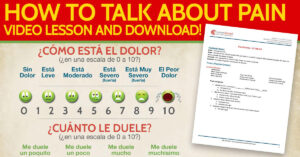This Free Medical Spanish lesson focuses on discussing headaches in Spanish: el dolor de cabeza.
In this lesson, we’re discussing stress headaches, migraines, cluster headaches, sinus pain, strokes, concussions and vision problems. For each cause of headaches, I’m sharing a basic description in Spanish and some simple tests and procedures. Here is the Headaches in Spanish video lesson I taught to the Facebook group:
Subscribe to our YouTube Channel to see all of our lessons and get the latest videos right away!
Dos lecciones para consultar / Two Lessons for Review and further discussion on pain and taking a medical history in Spanish:
Anatomía básica / Basic Anatomy
As we did in the other lessons, let’s start with a quick review of the basic anatomy in Spanish related to headaches.
Signos y síntomas / Signs and Symptoms
Here are some symptoms that might be causing the headaches to your patient and the pain level and they could be describing to you.
Signos y síntomas de alerta / Warning Signs and Symptoms
Learning this vocabulary is crucial if you want to be able to make a good diagnosis for the headaches of your patient.
Causas comunes / Common Causes
Here you can find listed seven common causes of headaches and their signs and symptoms in Spanish and English for practicing
| Spanish | English |
| 1. Tensión / estrés: Tensión en los músculos de los hombros, el cuello, la mandíbula y el cuello cabelludo pueden provocar dolor de cabeza. El estrés, saltar comidas, tomar demasiado licor, deshidratación y no dormir lo suficiente pueden contribuir a dolores de cabeza de tensión. | 1. Stress / stress: Tension in the muscles of the shoulders, neck, jaw and scalp can cause headaches. Stress, skipping meals, drinking too much alcohol, dehydration and not getting enough sleep can all contribute to tension headaches. |
| 2. Migrañas: Las migrañas son un dolor intenso y punzante que se empeora gradualmente. Puede empezar en la frente, en un lado de la cabeza o alrededor de los ojos. Pueden ser acompañadas por cambios de visión, nauseas, vomito y sensibilidad a la luz y ruidos. | 2. Migraines: Migraines are an intense, throbbing pain that gets worse gradually. It can start on the forehead, on the side of the head or around the eyes. They can be accompanied by changes in vision, nausea, vomiting and sensitivity to light and noise. |
| 3. Dolor de cabeza “en racimos”: Un dolor de cabeza repentino y muy fuerte. Pueden atacar un lado de la cabeza o detrás de un ojo. Pueden despertarlo en la noche. Son parecidos a la migraña y pueden durar hasta 3 horas. | 3. Cluster Headaches: A sudden and very strong headache. They can attack one side of the head or behind one eye. They can wake you up at night. They are similar to migraine and can last up to 3 hours. |
| 4. Dolor de cabeza por sinusitis: La congestión que tiene con una infección e inflamación de los senos nasales y paranasales durante un resfriado pueden causar dolores de cabeza. | 4. Sinusitis headache: The congestion you have with an infection and inflammation of the sinuses and paranasal during a cold can cause headaches. |
| 5. Conmoción cerebral: Una lesión al cerebro causado por un golpe en la cabeza. Por el golpe, el cerebro mueve violentamente para adelante y atrás. Este movimiento hace que el cerebro golpee el cráneo y puede provocar convulsiones, somnolencia, confusión, perdida de conocimiento. Es importante un tiempo de reposo y no volver a golpear la cabeza. | 5. Concussion: A brain injury caused by a blow to the head. By the blow, the brain moves violently back and forth. This movement causes the brain to hit the skull and can cause seizures, drowsiness, confusion, loss of consciousness. It is important a time of rest and not hitting the head again. |
| 6. Accidente cerebral: Los accidentes cerebrales también son conocidos como derrame cerebral. Pueden ser causados por sangrados o falta de sangre en una parte de la cabeza. Resultan en confusión, debilidad, dificultad para hablar, somnolencia, entumecimiento, etc – es una emergencia. | 6. Stroke: Strokes can be caused by bleeding or lack of blood in one part of the head. They result in confusion, weakness, difficulty speaking, drowsiness, numbness, etc. – it is an emergency. |
| 7. Problemas de la visión:Si una persona tiene problemas de visión y no usa lenes o lentes de contacto, tiene que esforzarse para ver. Este esfuerzo extra puede provocar dolores de cabeza. | 7. Vision problems: If a person has vision problems and does not wear lenses or contact lenses, he or she has to work hard to see. This extra effort can cause headaches. |
Exámenes y procedimientos / Tests and Procedures
Finally, this a simple list of tests your patient might need to get or some procedures you could try to get your patient to relieve their headaches 🙂
Sugerencias para ayudar / Suggestions That Might Help
Do you want to give them some recommendations in Spanish to improve their live quality and avoid having headaches? Here are some examples you could use:
PD: Two Updates for you! / ¡Dos noticias!
1. Immersion Programs: this is the best way for you to gain comfort, confidence, and fluidity in your expression in Spanish. If interested, check our Medical Immersion Programs.
2. Medical Spanish Verbs in Past Tenses: Beta testers are working hard on this course revision so it will be ready soon!
Now is your turn! ¡Ahora te toca a ti!
Study all this vocabulary with the flashcards below
Download the lesson notes and start creating your own questions and phrases using this new vocabulary in Spanish and share it on the comments below or in our Facebook group to receive feedback from other Medical Spanish learners
I packaged all of this into easily downloadable .pdf notes – Get your copy for free today
Keep up the good work speaking responsible Spanish to your patients! Check out our other books, classes & products to help you !
*If the link isn’t working for you, you may need to unblock pop-ups in your browser settings







